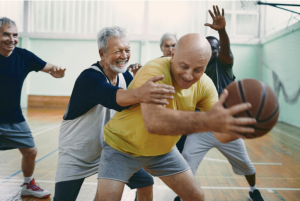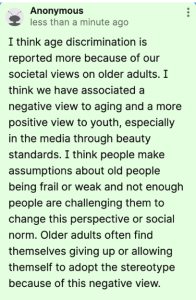7
Section One: The Fundamentals
A) Keywords
Exercise 1:
Provide a brief definition of one of the padlet keywords for this week.
| Aging habitus refers to the ways people age and the different factors that affect aging like cultural norms, attitudes and environments. It’s about perception and how it influences our self image and experience in the aging process. |
B) The Social Significance of Aging in Sport
Exercise 2: Notebook Prompt
How is old age popularly represented today? Find an image online that you think exemplifies one defining attitude towards old age and paste in your notebook below with a brief explanation of what this image means to you.

I think this describes how old age is popularly represented today because it shows a man using an assistive device and getting special help from an assistive personnel. This image to me means old age is represented as incapable or with poor health and in need of health services. |
Exercise 3: Notebook Prompt
What does the article (referencing another study by Dionigi) mean by its statement that sport can help aging people to simultaneously “accept and resist the ageing process” (572)? Respond by audio or text and find paste two images sourced online into your notebook showing how sport might help aging people to both accept and resist the aging process.
| It means as an older adult you can either accept the experience of aging, like the change of body, and give up, or resist the aging process by challenging yourself to play sports despite the aging process. You can either agree to live in the stereotypes of older adults being too weak or having too poor health and being incapable, or fight against them to prove being older, although there may be more challenges, does not mean less capable.
Accept:
Resist:
|
Exercise 4: Notebook Prompt
Who are the groups less likely to have extensive opportunities to take part in sports, according to Pike? How does privilege factor into aging and sport? (200 words max)
| The groups less likely to have extensive opportunities to take part in sports include people with disabilities, the very frail, some minor ethnic groups, people in care facilities and people living in rural areas. Privilege factors into aging and sport because people who lack resources lack understanding of sports, or societal expectations placed on people like women being ‘not meant for sports’ or grandparents ‘not being able to play sports’ can reduce activity participation. |
Exercise 5: Padlet Discussion
Why do you think age discrimination is “reported more than any form of prejudice” with older people presented as a threat to social values and interests? Feel welcome to use video in your responses. Paste your comments (or transcript of your video) below!
| I think age discrimination is reported more because of our societal views on older adults. I think we have associated a negative view to aging and a more positive view to youth, especially in the media through beauty standards. I think people make assumptions about old people being frail or weak and not enough people are challenging them to change this perspective or social norm. Older adults often find themselves giving up or allowing themself to adopt the stereotype because of this negative view. |
B) Older Women and Sport
Exercise 6: Notebook Prompt
What differences do you see in these ads? Which one is more inclusive? How is age represented or not represented in each? Answer these questions in your notebook.
| There are differences in age, gender and weight, for example, the Nike ad shows mostly youth competing in professional sports where everyone is fit. In the second one, it shows all girls but different ages, weights, not all fit. They promote different messages, for example, the Nike ad promotes sport in a way that brings people together whereas the second one promotes the capabilities of all girls. I think the second ad is more inclusive because it shows variety in different bodies and levels of fitness, as well as sports, whereas the other one only shows fit athletes competing in mainstream competitions. Although the second one only shows women, it is still promoting inclusivity in the way that it fights the stereotype of girls not being strong enough to do activities that guys can. Age is not promoted in the first one, but in the second one it demonstrates how all ages can be active and that there are different activities to fit different capabilities. |
Exercise 7: Notebook Prompt
In her article, “Assessing the sociology of sport: On age and ability,” Elizabeth Pike references a “trend towards a ‘feminisation of ageing’, with many women living longer than men” (573). Do you agree that aging has been “feminized” in this way? How? Answer these questions in your notebook.
| I do agree that aging has been feminized because women generally live longer than women for one, but also the media focuses on women struggling with stereotypes like being less sexually desirable or physical changes, and how women should fight back, reducing the sole focus of aging. Our culture has also created gendered expectations and there are also lots of beauty standards placed by society on women so there is a focus on looking young or using anti aging creams. |
Section Three: Module Mini Assignment
| Pickleball has become a popular sport trend very similar to tennis but with a smaller court and a lower intensity, allowing people to play without too much physical activity or strength. There is a belief that old people are frail and weak and therefore should not be over using their energy or strength (Pike, 2014). Pickleball has offered people an opportunity to participate in a socially acceptable way. There are also stereotypes and labelling for older adults who are unable to meet the expectations of level of exercise people in the same age groups should meet (Pike, 2014). Pickleball is a good sport that fits the capability of older adults but because of this, the media has portrayed it as an ‘old person sport’.
The issue in the pickleball debate is people do not agree with the creation of a pickleball court in place of the fields in the park. People argue to keep the grass because it soaks up water during floods, with pavement the city would be more hot, neighbours do not want the noise of the construction, and that they were not a part of or aware of this plan (Morrison, 2023). It would be a big change for the people living in peterborough and citizens are concerned it is not the best use of the city’s money. For example, despite peterborough’s small population, there is a housing crisis and even with emergency shelters people are continuing to struggle with the rising cost of living (MSN, 2023). Ageism may also be a factor associated in this debate. People are arguing that there would be no room for young kids or families in the area (Global News, 2023). This contributes to the belief that pickleball is a sport for older people, and that kids would not be playing pickleball. It also shows how youth is more favourable than the other generation.
References Global News. (2023, May 10). Pickleball protest: Residents protest Bonnerworth Park redevelopment project [Video]. Global News. https://globalnews.ca/video/10385921/pickleball-pickle-residents-protest-bonnerworth-park-redevelopment-project Morrison, C. (2023, April 6). Peterborough pickleball paves the way for park redevelopment.The Narwhal. https://thenarwhal.ca/opinion-peterborough-pickleball-paves-park/ MSN. (2023, April 7). Pickleball or housing? Debate in this Ontario city shows dilemma municipalities face. MSN. https://www.msn.com/en-ca/news/politics/pickleball-or-housing-debate-in-this-ontario-city-shows-dilemma-municipalities-face/ar-AA1pKYjb Pike, E. C. J. (2014). Assessing the sociology of sport: On age and ability. Sociology of Sport Journal, 31(5), 473–484. https://doi.org/10.1177/1012690214550009
|





